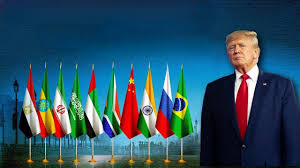
Foreign ministers from the BRICS nations gathered in Rio de Janeiro this week to craft a coordinated response to the sweeping tariffs and unilateral trade measures imposed by U.S. President Donald Trump. In their first high-level meeting under Brazil’s rotating presidency, the bloc—which now includes Egypt, Saudi Arabia, the United Arab Emirates, Ethiopia, Indonesia and Iran alongside its founding five members—laid out a multifaceted blueprint aimed at defending global trade norms and shielding member economies from further disruptions.
In opening remarks, Brazil’s Foreign Minister emphasized that BRICS would “reaffirm our commitment to multilateral trade negotiations” while condemning any “unilateral measures that distort markets and harm consumers.” Chinese and Russian envoys, both of whose economies have been hardest hit by Trump’s 145 percent levy on certain imports and retaliatory duties, pressed for a stronger tone. Ultimately, the draft communique struck a balance: unequivocal criticism of protectionism paired with an invitation to reengage diplomatically through the World Trade Organization (WTO).
At the heart of BRICS’s counterplan is an effort to leverage their combined economic weight—nearly 40 percent of global GDP—to push for rapid reform of the WTO’s dispute-settlement mechanism. Ministers agreed to accelerate coordination on joint complaints against U.S. tariffs, pooling legal resources and sharing intelligence on tariff classifications and injury assessments. By presenting a united front in Geneva, BRICS hopes to force Washington back to the negotiating table or, at minimum, deter additional punitive measures.
Complementing their legal strategy, BRICS nations pledged to bolster intra-group trade through preferential arrangements and local-currency settlement systems. India and China, already conducting more than half of their bilateral trade in rupees and yuan, announced plans to expand such settlements with Brazil’s real, Russia’s ruble and South Africa’s rand. To facilitate these transactions, member states agreed to fast-track development of “BRICS Pay,” a distributed payment messaging network designed to rival SWIFT and reduce reliance on the U.S. dollar.
The New Development Bank (NDB), BRICS’s multilateral lending arm, was tapped to underwrite infrastructure and supply-chain projects that can reduce member economies’ exposure to U.S.-centric trade routes. In a coordinated move, the NDB will prioritize loans for port modernization, rail linkages and digital-fiber deployments that tighten economic ties within the bloc and create alternative corridors for raw materials, components and finished goods.
Recognizing that small and medium-sized enterprises face the brunt of escalating duties and compliance costs, the ministers also unveiled plans for a joint “Anti-Tariff Contingency Fund.” Seeded by contributions from each capital—proportional to GDP—the fund will offer low-interest loans and temporary subsidies to exporters hit by sudden tariff hikes, helping them absorb cost shocks while they seek new markets or reconfigure supply chains.
Energy-exporting members, including Russia, Saudi Arabia and the UAE, signaled their readiness to use commodity leverage in service of the collective. They floated proposals to coordinate oil and gas shipments to blunt any U.S. threats of secondary sanctions, and to lock in multi-year purchase agreements at fixed prices for buyer nations like India and South Africa. These pacts, ministers asserted, can stabilize revenues and insulate energy markets from geopolitical brinkmanship.
On the diplomatic front, BRICS foreign ministers invited WTO leadership and other key stakeholders to observe their talks, underscoring the bloc’s ambition to serve as a de facto bridge between developed and developing economies. A special working group will engage with Least Developed Countries (LDCs) to extend technical assistance on customs procedures and tariff classification—measures designed to reinforce the principles of non-discrimination and fairness in global trade.
While climate-finance discussions were on the agenda—reflecting Brazil’s priority ahead of the United Nations climate summit in November—trade took center stage. Delegates emphasized that sustainable development and low-carbon transitions depend on predictable, affordable access to critical inputs such as renewable-energy components and efficiency-enhancing technologies. In a joint statement, ministers insisted that “rich countries must honor their commitments” to finance adaptation and mitigation, warning that climate action cannot be at odds with open, rules-based commerce.
Looking ahead, the ministers set a timeline to approve a final declaration at the upcoming full BRICS summit in Johannesburg this July. That declaration is expected to elaborate on institutional reforms, including the possible creation of a permanent BRICS trade council to monitor global tariff changes in real time and coordinate swift collective responses. Proposals are also on the table to hold annual “BRICS Trade Forums” bringing together private-sector leaders, trade unions and civil-society organizations to build consensus on standards ranging from e-commerce regulation to digital-data flows.
Analysts note that the success of BRICS’s strategy hinges on bridging divergent national interests. Brazil and South Africa, with closer ties to Western markets, have been wary of alienating major trading partners. In contrast, China, Russia and Iran have championed an assertive posture. To maintain unity, Brazil’s presidency has adopted a mediating role, favoring pragmatic steps—such as joint WTO filings and payment-system development—that deliver tangible benefits without veering into open confrontation.
By mid-2026, when member states must meet licensing deadlines for digital payments platforms and trade-facilitation projects, BRICS will have had the opportunity to test its new mechanisms against real-world challenges. Should the group secure meaningful concessions from the United States or compel changes to WTO procedures, it will mark a significant shift in the balance of power in global trade governance.
Yet, even if Washington digs in its heels, BRICS stands to gain: deeper economic integration, diversified supply chains and enhanced bargaining power in multilateral forums. Whether through legal challenges, financial innovation or commodity cooperation, the bloc has signaled that it will not passively absorb tariffs, opting instead for an assertive, coordinated push-back on behalf of its 3 billion-plus population and fast-growing economies.
As negotiators return to their capitals to refine the draft declaration, all eyes will be on how swiftly BRICS can operationalize its ambitious agenda. With the specter of further U.S. tariffs looming—and Washington’s leaders promising additional unilateral measures—this new collective strategy may prove the most consequential development in global trade policy so far this year.
(Source:www.france24.com)
In opening remarks, Brazil’s Foreign Minister emphasized that BRICS would “reaffirm our commitment to multilateral trade negotiations” while condemning any “unilateral measures that distort markets and harm consumers.” Chinese and Russian envoys, both of whose economies have been hardest hit by Trump’s 145 percent levy on certain imports and retaliatory duties, pressed for a stronger tone. Ultimately, the draft communique struck a balance: unequivocal criticism of protectionism paired with an invitation to reengage diplomatically through the World Trade Organization (WTO).
At the heart of BRICS’s counterplan is an effort to leverage their combined economic weight—nearly 40 percent of global GDP—to push for rapid reform of the WTO’s dispute-settlement mechanism. Ministers agreed to accelerate coordination on joint complaints against U.S. tariffs, pooling legal resources and sharing intelligence on tariff classifications and injury assessments. By presenting a united front in Geneva, BRICS hopes to force Washington back to the negotiating table or, at minimum, deter additional punitive measures.
Complementing their legal strategy, BRICS nations pledged to bolster intra-group trade through preferential arrangements and local-currency settlement systems. India and China, already conducting more than half of their bilateral trade in rupees and yuan, announced plans to expand such settlements with Brazil’s real, Russia’s ruble and South Africa’s rand. To facilitate these transactions, member states agreed to fast-track development of “BRICS Pay,” a distributed payment messaging network designed to rival SWIFT and reduce reliance on the U.S. dollar.
The New Development Bank (NDB), BRICS’s multilateral lending arm, was tapped to underwrite infrastructure and supply-chain projects that can reduce member economies’ exposure to U.S.-centric trade routes. In a coordinated move, the NDB will prioritize loans for port modernization, rail linkages and digital-fiber deployments that tighten economic ties within the bloc and create alternative corridors for raw materials, components and finished goods.
Recognizing that small and medium-sized enterprises face the brunt of escalating duties and compliance costs, the ministers also unveiled plans for a joint “Anti-Tariff Contingency Fund.” Seeded by contributions from each capital—proportional to GDP—the fund will offer low-interest loans and temporary subsidies to exporters hit by sudden tariff hikes, helping them absorb cost shocks while they seek new markets or reconfigure supply chains.
Energy-exporting members, including Russia, Saudi Arabia and the UAE, signaled their readiness to use commodity leverage in service of the collective. They floated proposals to coordinate oil and gas shipments to blunt any U.S. threats of secondary sanctions, and to lock in multi-year purchase agreements at fixed prices for buyer nations like India and South Africa. These pacts, ministers asserted, can stabilize revenues and insulate energy markets from geopolitical brinkmanship.
On the diplomatic front, BRICS foreign ministers invited WTO leadership and other key stakeholders to observe their talks, underscoring the bloc’s ambition to serve as a de facto bridge between developed and developing economies. A special working group will engage with Least Developed Countries (LDCs) to extend technical assistance on customs procedures and tariff classification—measures designed to reinforce the principles of non-discrimination and fairness in global trade.
While climate-finance discussions were on the agenda—reflecting Brazil’s priority ahead of the United Nations climate summit in November—trade took center stage. Delegates emphasized that sustainable development and low-carbon transitions depend on predictable, affordable access to critical inputs such as renewable-energy components and efficiency-enhancing technologies. In a joint statement, ministers insisted that “rich countries must honor their commitments” to finance adaptation and mitigation, warning that climate action cannot be at odds with open, rules-based commerce.
Looking ahead, the ministers set a timeline to approve a final declaration at the upcoming full BRICS summit in Johannesburg this July. That declaration is expected to elaborate on institutional reforms, including the possible creation of a permanent BRICS trade council to monitor global tariff changes in real time and coordinate swift collective responses. Proposals are also on the table to hold annual “BRICS Trade Forums” bringing together private-sector leaders, trade unions and civil-society organizations to build consensus on standards ranging from e-commerce regulation to digital-data flows.
Analysts note that the success of BRICS’s strategy hinges on bridging divergent national interests. Brazil and South Africa, with closer ties to Western markets, have been wary of alienating major trading partners. In contrast, China, Russia and Iran have championed an assertive posture. To maintain unity, Brazil’s presidency has adopted a mediating role, favoring pragmatic steps—such as joint WTO filings and payment-system development—that deliver tangible benefits without veering into open confrontation.
By mid-2026, when member states must meet licensing deadlines for digital payments platforms and trade-facilitation projects, BRICS will have had the opportunity to test its new mechanisms against real-world challenges. Should the group secure meaningful concessions from the United States or compel changes to WTO procedures, it will mark a significant shift in the balance of power in global trade governance.
Yet, even if Washington digs in its heels, BRICS stands to gain: deeper economic integration, diversified supply chains and enhanced bargaining power in multilateral forums. Whether through legal challenges, financial innovation or commodity cooperation, the bloc has signaled that it will not passively absorb tariffs, opting instead for an assertive, coordinated push-back on behalf of its 3 billion-plus population and fast-growing economies.
As negotiators return to their capitals to refine the draft declaration, all eyes will be on how swiftly BRICS can operationalize its ambitious agenda. With the specter of further U.S. tariffs looming—and Washington’s leaders promising additional unilateral measures—this new collective strategy may prove the most consequential development in global trade policy so far this year.
(Source:www.france24.com)














